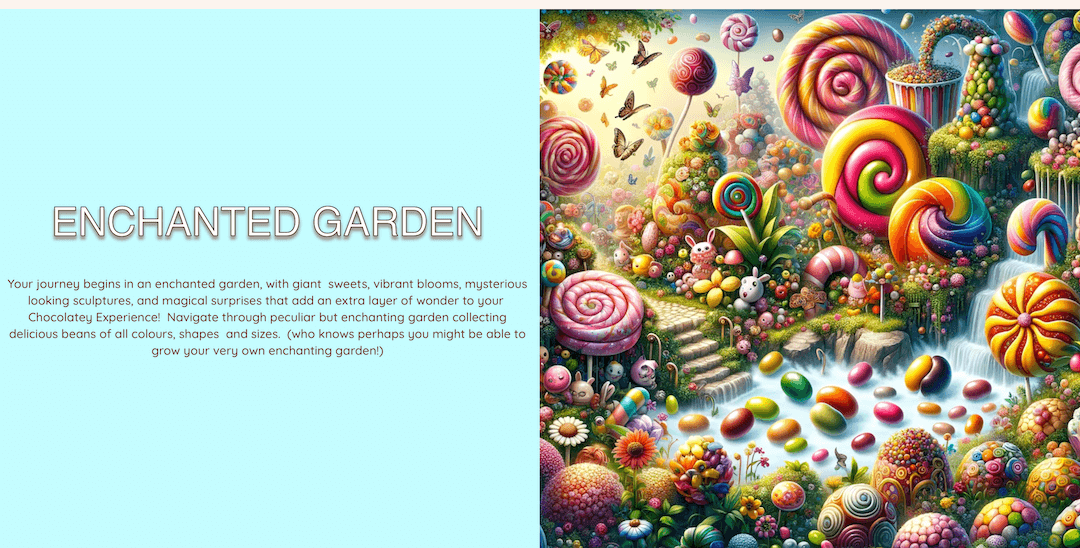I first saw the sad warehouse post on Tuesday while preparing for a panel on AI use and ethics. X user Chris Alsikkan posted two images, one showing a fantastical dreamscape of giant lollipops and peppermints the size of sofas, in which whimsical light bounced off the walls and gumdrops led guests toward a magical tunnel. The other looked like party favors from a children’s party that ended in disaster, the remnants left beside a dumpster along with childhood hopes and dreams.
The Glasgow event, Willy’s Chocolate Experience, was billed as “a place where chocolate dreams become reality.” In truth, it was where dreams turned into nightmares, the cops were called and The New York Times, among many other outlets, reported on it.
apparently this was sold as a live Willy Wonka Experience but they used all AI images on the website to sell tickets and then people showed up and saw this and it got so bad people called the cops lmao pic.twitter.com/tfkyg0G0WG
— Chris Alsikkan (@AlsikkanTV) February 26, 2024
I’ve spent the last six months researching and writing about visual artificial intelligence use. I’ve experimented with it myself, creating illustrations for my teaching and presentation decks. I’ve seen companies struggle to stop disinformation and read about people dealing with the horrific aftermath of nudify apps being used against teens and women.
Those are all really big issues to grapple with. But I can safely say that there’s not a world in which I thought a ridiculous story like Willy’s Chocolate Experience could help showcase the major AI issues we’re facing.
When I stop to think about it, it’s not surprising. A lot of events have drawn me in with a stock image and a flowery description of the great time I will have. When you look at the whimsical, bright colorful images the site showcased, it’s no wonder people lined up expecting to see something resembling a Tim Burton movie set.

(Screenshot/Willy’s Chocolate Experience)
But to those of us keeping a close eye on AI, it’s obvious the site was populated with AI-created illustrations. Most of the image generator tools have a default digital art style that looks similar. They tend to be very colorful and packed with visual content. For Willy’s site, the wild misspellings are a dead giveaway.
But the general public doesn’t yet pay attention to AI like we do. On good faith, the illustrations are representative of what one should expect to see at the event. The misspelling? Perhaps it’s a fanciful tribute to Roald Dahl. Who wouldn’t want an “exarserdray lollipop?”

(Screenshot/Willy’s Chocolate Experience)
In the 1971 film version, Gene Wilder’s Wonka tells visitors there’s “little surprises around every corner, but nothing dangerous.” AI has sparked the opposite, a lot of giant surprises and big, scary issues hiding around every corner. But I didn’t think we would have to guard ourselves against event organizers using the technology to overpromise and underdeliver.
While listening to a recent episode of “Offline with Jon Favreau,” Favreau and international reporter and columnist Max Fisher discussed how scammers created a deepfake of Selena Gomez giving away Le Creuset cookware. It’s very easy to see how people would fall for the scam. Gomez has a cooking show on Max, meaning there’s a lot of footage of her that can easily be used to train an AI model. Combine that with her fans’ parasocial relationship and it’s a recipe for manipulation. Even that scam was just a clone of one that had used Taylor Swift.
It’s always been possible to create content like this, but you needed the skills to develop a website, illustrate the art or manipulate images in Photoshop (that you paid for or illegally copied), spend time writing the copy, shoot video, edit it, create the social campaign then post it. Those are all different skill sets that people spend their careers developing. Now, one person can do it easily in a few hours at most. All it takes is a credit card and an impure imagination.
I’m concerned with how fast the technology is changing, and how it’s nearly impossible to keep up with it, report on it and create guardrails for it. Something I should have been prepared for, but didn’t expect, was just how fast people would find ways to use it to swindle people.
In the case of Willy’s Chocolate Experience, some parents wasted their hard-earned money and had a terrible time. In the Gomez scam, people will spend their valuable time disputing charges on their credit card, or will wait by the mailbox for a new cookware set that will never come — while they rack up monthly charges they never authorized.
As we continue to report, analyze and discuss AI, we need to keep these instances in mind. There are the huge societal consequences that deeply harm people, then there are the smaller things we may not think about, or cover as much, that can be equally harmful.
It’s my (tiny little bit of) hope AI can be properly regulated, studied and deployed for good, but I worry Willy is already out of the lamp, and my hope is just a paper-mache rainbow held together with scotch tape and staples.







